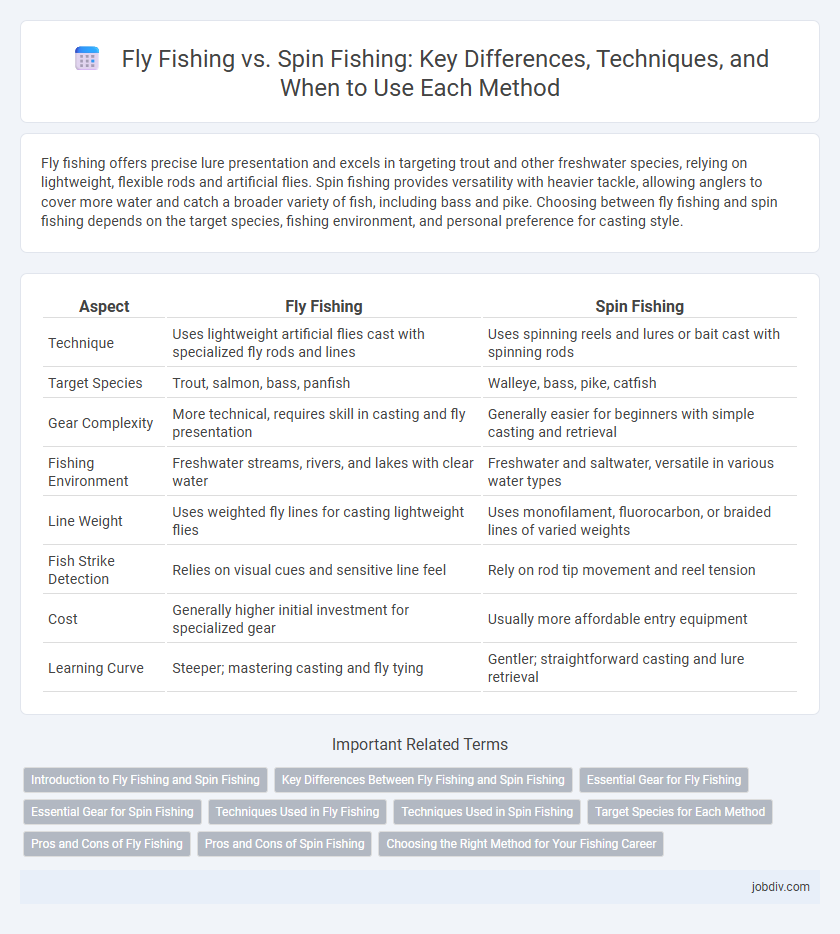Fly fishing offers precise lure presentation and excels in targeting trout and other freshwater species, relying on lightweight, flexible rods and artificial flies. Spin fishing provides versatility with heavier tackle, allowing anglers to cover more water and catch a broader variety of fish, including bass and pike. Choosing between fly fishing and spin fishing depends on the target species, fishing environment, and personal preference for casting style.
Table of Comparison
| Aspect | Fly Fishing | Spin Fishing |
|---|---|---|
| Technique | Uses lightweight artificial flies cast with specialized fly rods and lines | Uses spinning reels and lures or bait cast with spinning rods |
| Target Species | Trout, salmon, bass, panfish | Walleye, bass, pike, catfish |
| Gear Complexity | More technical, requires skill in casting and fly presentation | Generally easier for beginners with simple casting and retrieval |
| Fishing Environment | Freshwater streams, rivers, and lakes with clear water | Freshwater and saltwater, versatile in various water types |
| Line Weight | Uses weighted fly lines for casting lightweight flies | Uses monofilament, fluorocarbon, or braided lines of varied weights |
| Fish Strike Detection | Relies on visual cues and sensitive line feel | Rely on rod tip movement and reel tension |
| Cost | Generally higher initial investment for specialized gear | Usually more affordable entry equipment |
| Learning Curve | Steeper; mastering casting and fly tying | Gentler; straightforward casting and lure retrieval |
Introduction to Fly Fishing and Spin Fishing
Fly fishing utilizes lightweight artificial flies cast with specialized flexible rods and tapered lines to mimic insects on water surfaces, targeting species like trout and salmon. Spin fishing employs spinning reels and heavier lures or live bait, offering versatility in various water conditions and suitable for catch of diverse fish such as bass and pike. Both techniques require distinct equipment and skills, catering to different fish behaviors and angler preferences.
Key Differences Between Fly Fishing and Spin Fishing
Fly fishing employs lightweight rods and artificial flies to mimic insects, targeting species like trout in freshwater streams. Spin fishing uses heavier spinning rods and reels with a variety of lures or bait, suitable for catching larger fish such as bass and pike. The key differences lie in casting techniques, gear complexity, and specific fish species targeted by each method.
Essential Gear for Fly Fishing
Fly fishing essential gear includes a lightweight fly rod, typically 7-9 feet long, paired with a specialized fly reel designed for smooth line retrieval. A floating or sinking fly line, tapered for accurate casting, is crucial alongside various artificial flies imitating insects or baitfish. Key accessories include a sturdy vest with multiple pockets, polarized sunglasses for water visibility, and waders for fishing in streams or rivers.
Essential Gear for Spin Fishing
Spin fishing requires a robust spinning reel paired with a lightweight or medium-action spinning rod that balances sensitivity and strength. Essential gear includes durable monofilament or braided fishing line, versatile lures such as spinners, spoons, and soft plastics, and a quality tackle box for organized storage. Proper hooks, sinkers, and a reliable rod holder enhance maneuverability and increase catch rates in various fishing environments.
Techniques Used in Fly Fishing
Fly fishing emphasizes the skillful casting of lightweight artificial flies using a specialized fly rod, reel, and weighted line designed to mimic natural insect movements on the water surface. Techniques such as dry fly presentation, nymphing, and streamer fishing require precise control of line tension and casting angles to effectively entice trout and other freshwater species. Fly anglers often employ roll casts, false casts, and delicate mending to achieve realistic drift and avoid spooking fish in streams and rivers.
Techniques Used in Spin Fishing
Spin fishing employs casting and retrieving lures or bait with spinning reels, allowing anglers to cover large water areas efficiently. Techniques include steady retrieve, stop-and-go, and twitching to mimic prey movements and trigger strikes. Versatile lures like spinners, spoons, and soft plastics are commonly used to target various freshwater and saltwater species.
Target Species for Each Method
Fly fishing primarily targets trout, salmon, and bass, utilizing artificial flies to mimic insects and small aquatic creatures in freshwater environments. Spin fishing is versatile, effectively targeting species such as pike, walleye, catfish, and various saltwater fish by using a wide range of lures and bait. Each method suits distinct habitats and fish behaviors, optimizing success based on the targeted species' feeding patterns.
Pros and Cons of Fly Fishing
Fly fishing offers exceptional precision and control, allowing anglers to mimic natural insect behavior and target specific fish species in freshwater habitats. However, it requires mastering complex casting techniques and investing in specialized gear, which can be costly and challenging for beginners. Despite these drawbacks, fly fishing excels in providing a highly engaging and immersive angling experience, especially in trout and salmon fishing scenarios.
Pros and Cons of Spin Fishing
Spin fishing offers greater versatility with its ability to cast lightweight lures over longer distances, making it ideal for targeting various fish species in different water conditions. The technique is easier for beginners to learn due to the straightforward casting and retrieval methods, but it often lacks the precision and subtle presentation available in fly fishing. Equipment for spin fishing is generally more affordable and durable, though it may not provide the same level of control for delicate presentations in clear or shallow waters.
Choosing the Right Method for Your Fishing Career
Fly fishing offers precise lure presentation and excels in targeting trout in freshwater streams, making it ideal for anglers seeking skill development and a connection with nature. Spin fishing provides versatility with various bait options and is effective in diverse environments, supporting faster learning curves and broader species targeting. Selecting the right method depends on your preferred fishing environment, target species, and whether you prioritize technique mastery or convenience.
Fly Fishing vs Spin Fishing Infographic

 jobdiv.com
jobdiv.com